You have no items in your shopping cart.
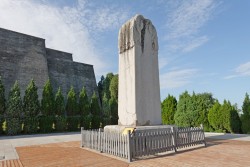

Introducing Qianling Mausoleum of Tang Dynasty
Qianling Mausoleum lies 85 km (53 mi) northwest of Xi'an. Qianling Mausoleum is a Tang Dynasty (618-907) imperial tomb. Built in 684 (with additional construction until 706), Qianling Mausoleum houses the remains of Emperor Gaozong who ruled China from 649 to 683, as well as his wife, Wu Zetian, who assumed the Tang throne and became China's only reigning female emperor from 690–705. The mausoleum is renowned for its many Tang dynasty stone statues located above ground. Besides the main tumulus mound and underground tomb of Emperor Gaozong and Wu Zetian, there are 17 smaller attendant tombs. Presently, five of these attendant tombs have been excavated by archaeologists.
Watch this video showcasing Qianling Mausoleum
Kind Notice: This video is not available in China (YouTube is blocked). If you are in China, click here.
Qianling Mausoleum Fast Facts
• Chinese Name: Qian Ling 乾陵
• Best Time to Visit: Apr, May, Sept & Oct.
• Recommended Visiting Hours: 2 hours
• Distance from Xian: 85 km (53 mi)
• Opening Hours
Mar 1 to Nov 30: 8:00-18:00
Dec 1 to Feb 28: 8:30-17:30
• Entrance Fee
Mar 1 to Nov 30: CNY100
Dec 1 to Feb 28: CNY80
• Address: Qianling, Qian County, Xianyang
Layout of Qianling Mausoleum
Emperor Gaozong was buried here at Qianling Mausoleum in 684 following his death a year earlier. After her death, Wu Zetian was interred in a joint burial with Emperor Gaozong at Qianling in 706. It can be seen that Qianling Mausoleum is identical of the city planning of Chang'an (Tang Dynasty capital and today’s Xian). Chang'an was made up by three walled cities. The center was the walled Palace City for the imperial family, surrounded by the walled Royal City from its east, south and west. The Royal City for government offices was surrounded by the walled Outer City from its east, south and west. Qianling Mausoleum was built following this same concept of city planning. Three sets of ceremonial gates were built to the south of the tomb mountain. They represent three gates located on the central axis of the capital city of Chang'an. The first free-standing ceremonial gate represents Mingde Gate, the south gate of Chang'an's outer city; the second free-standing ceremonial gate represents the Vermillion Bird Gate, the south gate of Chang'an's royal city; the third ceremonial gate resembles the Gate of Heavenly Succession, the south gate of the Palace City of Chang'an. The tomb mountain was protected by a rectangular shaped wall with four gates opened on its four cardinal directions. The gates were named after the four mythological creatures which were viewed as the guardians of the four cardinal directions: East Azure Dragon Gate, West White Tiger Gate, South Vermilion Bird Gate, and North Black Tortoise Gate. Two stone lions, one male and one female were placed inside the gate entrance as guarding lions. The Spirit Way was located between the second and third ceremonial gates to the south of the tomb mountain. The Spirit Way was lined on both sides with a succession of stone statues including a pair of ornamental columns, a pair of winged horses, a pair of ostriches, five pairs of saddled horses, 10 pairs of stone statues of government officials, seven-tiered stele and uncharactered stele. A miniature spirit way was built outside the Black Tortoise Gate in correspondence with the grand Spirit Way located outside the south Gate of Vermilion Bird. The miniature spirit way was lined on both sides by one pair of stone tigers standing together with their tamers, and three pairs of saddled horses.
Nipple Hills
The second set of free-standing towers symbolize the entrance to the Royal City of Chang'an. They are located on the southern peaks and are called by locals "Nipple Hills", due to their resemblance to the shape of nipples. The Nipple Hills, with towers erected on the top of each to accentuate the hills' name, form the second gateway into Qianling Mausoleum.
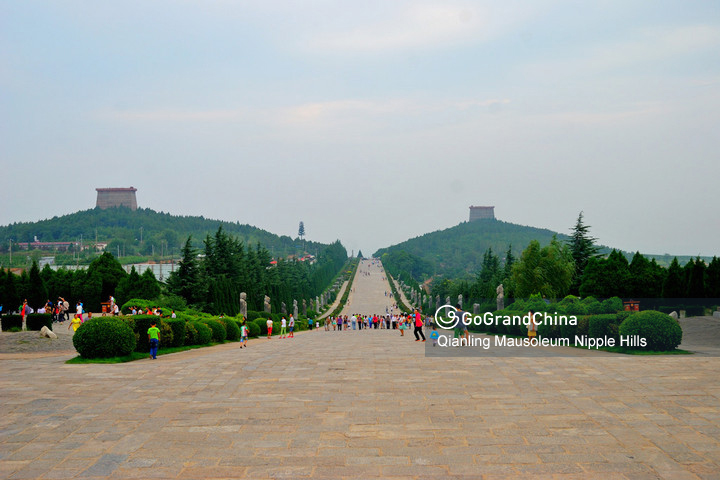
Spirit Way
Spirit way would symbolize the passage of the soul the dead emperor into the world of the spirits. Qianling Mausoleum set standard for the Spirit Way of later imperial tombs in China. A pair of Ornamental Columns, erected within the second set of Ceremonial Gate Towers which symbolize the entrance to the Royal City of Chang'an, marks the beginning of the Spirit Way of Qianling Tomb, followed by a pair of winged horses, a pair of ostriches, five pairs of saddled horses and 10 pairs of government officials. The Spirit Way ends at the third set of Ceremonial Gate Towers which symbolize the entrance to the Palace City of Chang'an.
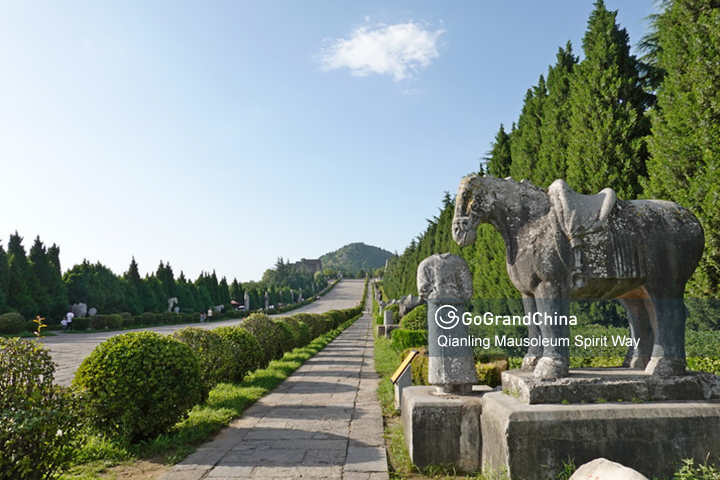
Ostriches of Spirit Way
A pair of ostriches are arranged along the Spirit Way as a sign of the greatness of China and the Chinese emperor. They were foreign tributes to the Tang imperial court from central Asian countries. It is recorded that the khan of the Western Turks presented an ostrich to the Tang court in 620 and the Tushara Kingdom sent another in 650. The carved reliefs of ostriches are dated the year of 683, traditional Chinese phoenixes are modelled on the body of ostriches.
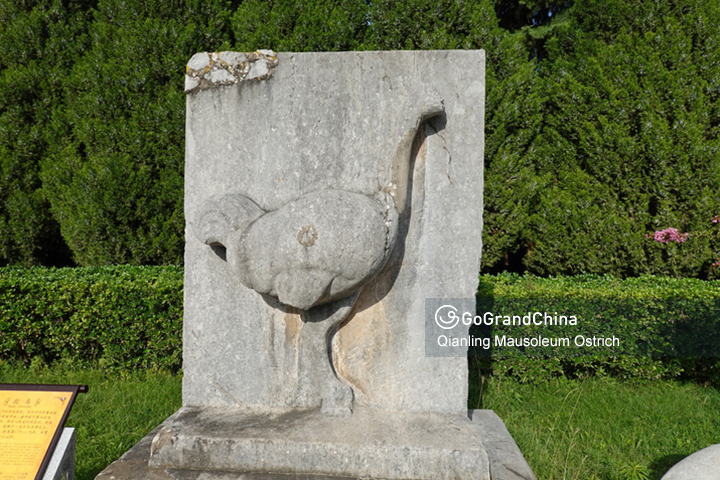
Uncharactered Stele
The Uncharactered Stele was built to commemorate Wu Zetian. Unlike other tablets located at the site, it has no written inscriptions. It weighs 98 tonnes and is decorated with sculpted dragons and oysters. Empress Wu Zetian was buried by his third son Emperor Zhongzong after her death. On her way to gain power, Wu Zetain killed her first daughter, first son and second son. After Wu Zetain became the Empress Regnant, she killed the first son and daughter of Zhongzong. Emperor Zhongzong erected this Uncharactered Stele because he did have nothing to say about her mother.
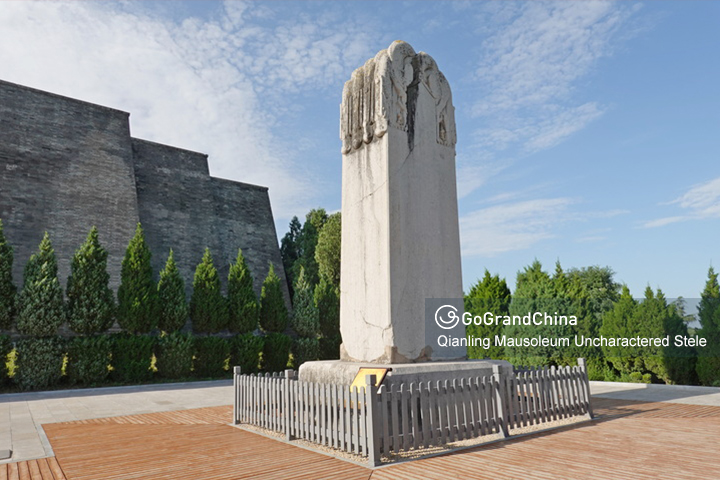
61 Statues of Foreign Diplomats
61 foreign ambassadors attended the funeral of Emperor Gaozong in 684. Their statues were created on the instructions of Empress Wu Zetian, who wanted a permanent reminder of their visit. Each figure is depicted in a long robe with a wide belt and wearing boots. The name of each individual and the country he represented is carved on the back of the statue. These statues, now headless, represent the far-reaching power and international standing of the Tang Dynasty.
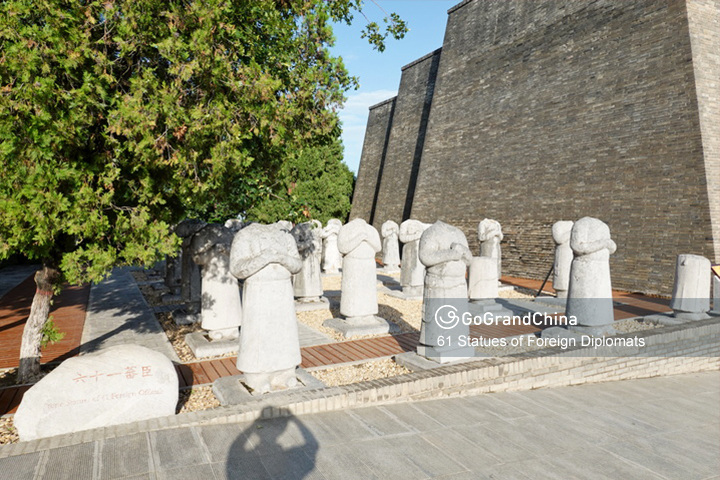
Tomb Chamber
The tomb chamber of Emperor Gaozong and Empress Wu is located deep within the 1049 (3,442 ft) meter hight Mount Liangshan. Halfway up Mount Liangshan, the builders of the site dug a 61 m (200 ft) long and 4 m (13 ft) wide tunnel into the rock of the mountain that leads to the inner tomb chambers located deep within the mountain. The entrance of the tunnel was found in 1962. It is believed that the Tomb Chamber of Qianling Mausoleum has never been looted. The Shaanxi Administration of Cultural Heritage declared in 2012 that no further excavations would take place for at least 50 years.
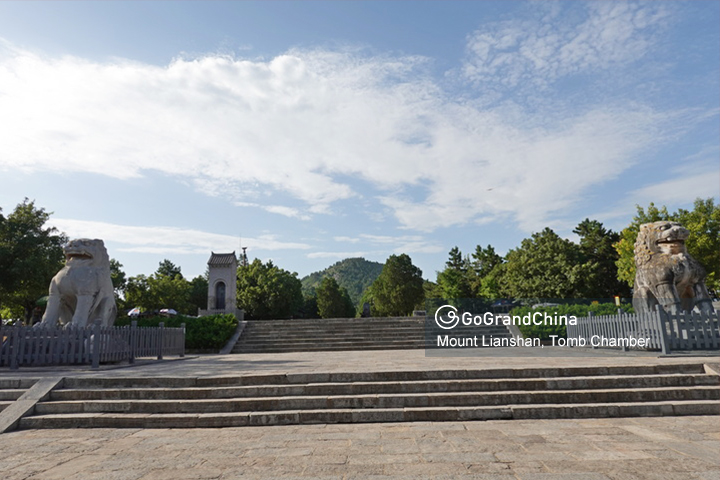
How to get to Qianling Mausoleum
• Qianling Mausoleum is located 85 km away from downtown Xian.
• Take a bus from Xian West Bus Station to Qian County, change to local bus No. 2 to Qian Ling.
• Rent a car/bus from GGC to enjoy a hassle free private transfer from hotels in Xian to Qianling Mausoleum.
Additional travel advice on Qianling Mausoleum
• Please wear comfortable hiking shoes if you want to hike up Mount Liangshan where the tomb chamber is located.
• UV is very strong in summer, please wear sunscreen, hat and sunglasses to prevent sunburns.